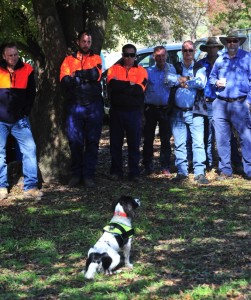Eradication is the most cost-effective and efficient way to manage new weed incursions. But often finding the ‘very last weed’ is difficult, especially for ‘hard-to-find’ weeds like orange hawkweed. Detector dogs can increase the ability to find even the smallest fragment of a target plant, making them a potentially powerful tool to help eradicate weeds. Orange hawkweed (Hieracium aurantiacum) is a Class 1 Noxious Weed that has the potential to become a serious environmental and agricultural weed across SE Australia. Although a major threat to biodiversity, should this weed reach its potential distribution, losses to the Australian grazing industry alone could be over $48 million/year. Currently in NSW, it is only recorded in Kosciuszko National Park, where a team of over 200 volunteers are assisting Parks staff to eradicate the weed. But eradication is difficult because small, obscure plants often escape detection, thus detector dogs may be able to help.
Detector dogs were critical to the eradication of pest animals on Macquarie Island, and are successfully used to detect foxes, cane toads and endangered birds in natural areas. This project, funded by the NSW Weeds Action Program, is applying these scientifically proven detection techniques (i.e. the highly effective ‘noses’ of detector dogs) in an innovative manner to improve weed eradication. ‘Botanist puppies’, who are officially known as Weed Eradication Detector Dogs (WEDDs), may allow us to ‘sniff out those very last weeds’ and eradicate high-risk weeds, such as orange hawkweed, from NSW.
This video shows Hillary Cherry, NPWS Weed Management Officer, under the guidance of Steve Austin (Canine Training and Behaviour Specialist ) learning to train Sally the detector dog to find hawkweed. The video captures one of the first instances in which Sally successfully ‘indicated’ on hawkweed, and as you can see we are very all impressed by what a quick learner she is!
Check out this link https://au.prime7.yahoo.com/n4/news/a/-/local/27454190/weed-sniffing-dog-not-what-you-think-video/ to see Missy and Sally in action at Kosciuszko National Park where both dogs were trialled in the field. Both were able to detect a live hawkweed plant (in situ) that Greg found for us. Missy then found another small plant nearby the first one, that was previously undetected. And both performed equally well the next day – despite the ground being covered in frost!
Thanks very much to Greg Cullen and Steve Austin for all their help.
Hillary Cherry
Weeds of National Significance Coordinator
Pests & Weeds Team
Office of Environment and Heritage NSW
JUN

